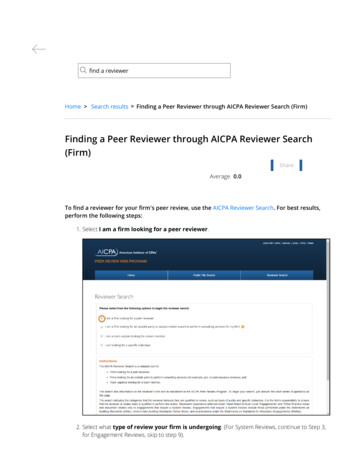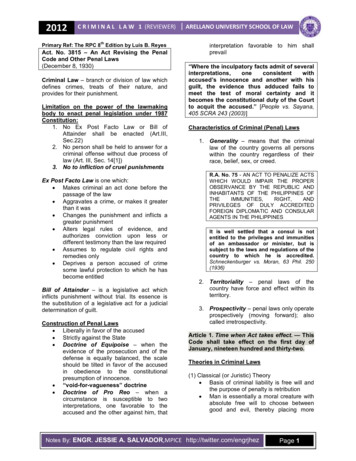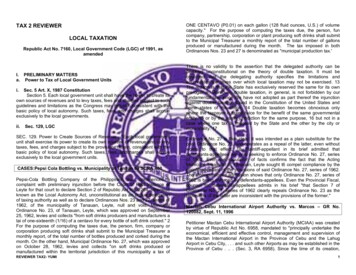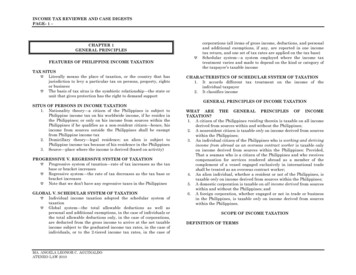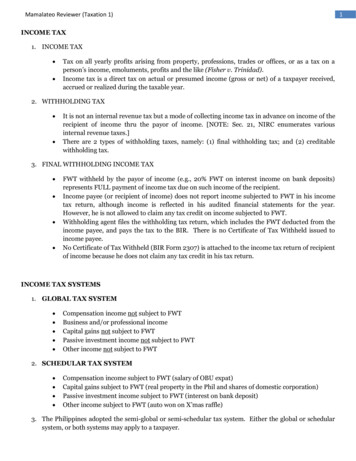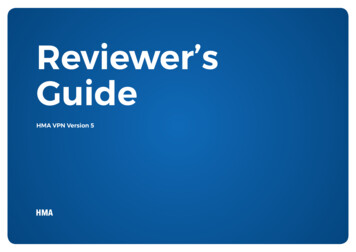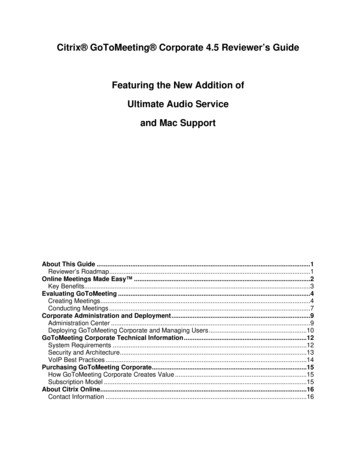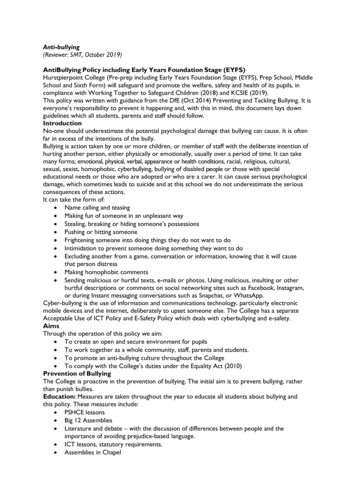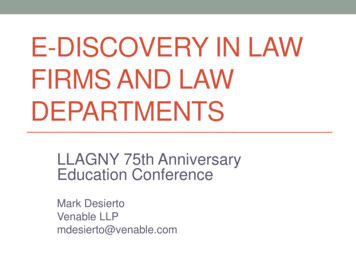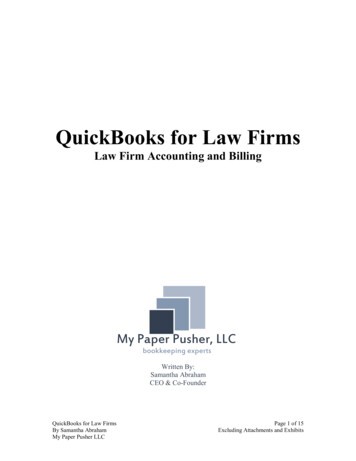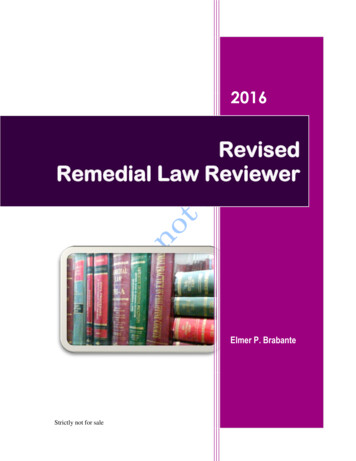
Transcription
2016RevisedRemedial Law ReviewerElmer P. BrabanteStrictly not for sale
TABLE OF CONTENTSI. CIVIL PROCEDURE191. General Principles221.1. Concept of remedial law1.2. Substantive law vis-a-vis remedial law1.3. Rule-making power of the Supreme Court1.3.1 Limitations on the rule-making power of the Supreme Court1.3.2. Power of the Supreme Court to amend and suspend procedural rules1.4. Nature of Philippine courts1.4.1. Meaning of a court1.4.2. Court as distinguished from a judge1.4.3. Classification of Philippine courts1.4.4. Courts of original and appellate jurisdiction1.4.5. Courts of general and special jurisdiction1.4.6. Constitutional and statutory courts1.4.7. Courts of law and equity1.4.8. Principle of judicial hierarchy1.4.9. Doctrine of non-interference or doctrine of judicial stability2. Jurisdiction272.1 Over the parties2.1.1. How jurisdiction over the plaintiff is acquired2.1.2. How jurisdiction over the defendant is acquired2.2 Over the subject matter2.2 1. Meaning of jurisdiction over the subject matter2.2 2. Jurisdiction versus the exercise of jurisdiction2.2 3. Error of jurisdiction as distinguished from error of judgment2.2 4. How jurisdiction is conferred and determined2.2 5. Doctrine of primary jurisdiction2.2 6. Doctrine of adherence of jurisdiction2.2 7. Objections to jurisdiction over the subject matter2.2 8. Effect of estoppel on objections to jurisdiction2.3. Over the issues2.4 Over the res or property in litigation2.5. Jurisdiction of courts2.5.1. Supreme Court2.5.2. Court of Appeals2.5.3. Court of Tax Appeals2.5.4. Sandiganbayan2.5.5. Regional Trial Courts2.5.6. Family Courts2.5.7. Metropolitan Trial Courts/Municipal Trial Courts2.5.8. Shariah Courts2.6. Over small claims; cases covered by the Rules on Summary ProcedureBarangay conciliation2.7 Totality ruleELMERP.BRABANTE24*REMEDI ALLAWREVI EWER2016Page 232
3. Civil Procedure443.1. Actions3.1.1. Meaning of ordinary civil actions3.1.2. Meaning of special civil actions3.1.3. Meaning of criminal actions3.1.4. Civil actions versus special proceedings3.1.5. Personal actions and real actions3.1.6. Local and transitory actions3.1.7. Actions in rem, in personam and quasi in rem3.1.8. Independent Civil Actions3.2. Cause of action3.2.1. Meaning of cause of action3.2.2. Right of action versus cause of action3.2.3. Failure to state a cause of action3.2.4. Test of the sufficiency of a cause of action3.2.5. Splitting a single cause of action and its effects3.2.6. Joinder and mis-joinder of causes of action3.3. Parties to civil actions3.3.1. Real parties in interest; indispensable parties; representatives asparties; necessary parties; indigent parties; alternative defendants3.3.2. Compulsory and permissive joinder of parties3.3.3. Misjoinder and non-joinder of parties3.3.4. Class suit3.3.5. Suits against entities without juridical personality3.3.6. Effect of death of party litigant3.4. Venue3.4.1. Venue versus jurisdiction3.4.2. Venue of real actions3.4.3. Venue of personal actions3.4.4. Venue of actions against non-residents3.4.5. When the rules on venue do not apply3.4.6. Effects of stipulations on venue3.5. Pleadings3.5.1. Kinds of pleadingsa) Complaintb) Answeri. Negative defensesii. Negative pregnantiii. Affirmative defensesc) Counterclaimsi. Compulsory counterclaimii. Permissive counterclaimiii. Effect on the counterclaim when the complaint is dismissedd) Cross-claimse) Third (fourth, etc.) party complaintsf) Complaint-in-interventiong) Reply3.5.2. Pleadings allowed in small claim cases and cases covered by theRules on Summary Procedure3.5.3. Parts of a pleadinga) Captionb) Signature and addressc) Verification and certification against forum shoppingELMERP.BRABANTE*REMEDI ALLAWREVI EWER2016Page 3444752586166
i. Requirements of a corporation executing the verification/certification ofnon-forum shoppingd) Effect of the signature of counsel in a pleading3.5.4. Allegations in a pleadinga) Manner of making allegationsi. Condition precedentii. Fraud, mistake, malice, intent, knowledge and other condition ofthe mind, judgments, official documents or actsb) Pleading an actionable documentc) Specific denialsi. Effect of failure to make specific denialsii. When a specific denial requires an oath3.5.5. Effect of failure to pleada) Failure to plead defenses and objectionsb) Failure to plead a compulsory counterclaim and cross-claim3.5.6. Defaulta) When a declaration of default is properb) Effect of an order of defaultc) Relief from an order of defaultd) Effect of a partial defaulte) Extent of relieff) Actions where default is not allowed3.5.7. Filing and service of pleadingsa) Payment of docket feesb) Filing versus service of pleadingsc) Periods of filing of pleadingsd) Manner of filinge) Modes of servicei. Personal serviceii. Service by mailiii. Substituted serviceiv. Service of judgments, final orders or resolutionsv. Priorities in modes of service and filingvi. When service is deemed completevii. Proof of filing and service3.5.8. Amendmenta) Amendment as a matter of rightb) Amendments by leave of courtc) Formal amendmentd) Amendments to conform to or authorize presentation of evidencee) Different from supplemental pleadingsf) Effect of amended pleading3.6. Summons3.6.1. Nature and purpose of summons in relation to actions in personam, inrem and quasi in rem3.6.2. Voluntary appearance3.6.3. Personal service3.6.4. Substituted service3.6.5. Constructive service (by publication)a) Service upon a defendant where his identity is unknown or hiswhereabouts are unknownb) Service upon residents temporarily outside the Philippines3.6.6. Extra-territorial service, when allowed3.6.7. Service upon prisoners and minorsELMERP.BRABANTE*REMEDI ALLAWREVI EWER2016Page 4707273758083
3.6.8. Proof of service3.7. Motions3.7.1. Motions in generala) Definition of a motionb) Motions versus pleadingsc) Contents and form of motionsd) Notice of hearing and hearing of motionse) Omnibus motion rulef) Litigated and ex parte motionsg) Pro-forma motions3.7.2. Motions for bill of particularsa) Purpose and when applied forb) Actions of the courtc) Compliance with the order and effect of noncomplianced) Effect on the period to file a responsive pleading3.7.3. Motion to dismissa) Groundsb) Resolution of motionc) Remedies of plaintiff when the complaint is dismissedd) Remedies of the defendant when the motion is deniede) Effect of dismissal of complaint on certain groundsf) When grounds pleaded as affirmative defensesg) Bar by dismissalh) Distinguished from demurrer to evidence under Rule 333.8. Dismissal of actions3.8.1. Dismissal upon notice by plaintiff; two-dismissal rule3.8.2. Dismissal upon motion by plaintiff; effect on existing counterclaim3.8.3. Dismissal due to the fault of plaintiff3.8.4. Dismissal of counterclaim, cross-claim or third-party complaint3.9. Pre-trial3.9.1. Concept of pre-trial3.9.2. Nature and purpose3.9.3. Notice of pre-trial3.9.4. Appearance of parties; effect of failure to appear3.9.5. Pre-trial brief; effect of failure to file3.9.6. Distinction between pre-trial in civil case and pre-trial in criminalcase3.9.7. Alternative Dispute Resolution (ADR)a) Special Rules of Court on ADR (A.M. No. 07-11-08-SC)3.10. Intervention3.10.1. Requisites for intervention3.10.2. Time to intervene3.10.3. Remedy for the denial of motion to intervene3.11. Subpoena3.11.1. Subpoena duces tecum3.11.2. Subpoena ad testificandum3.11.3. Service of subpoena3.11.4. Compelling attendance of witnesses; contempt3.11.5. Quashing of subpoena3.12. Modes of discovery3.12.1. Depositions pending action; depositions before action or pendingappeala) Meaning of depositionb) Uses; scope of examinationELMERP.BRABANTE*REMEDI ALLAWREVI EWER2016Page 589899294101103108110112
c) When may objections to admissibility be maded) When may taking of deposition be terminated or its scope limited3.12.2. Written interrogatories to adverse partiesa) Consequences of refusal to answerb) Effect of failure to serve written interrogatories3.12.3. Request for admissiona) Implied admission by adverse partyb) Consequences of failure to answer request for admissionc) Effect of admissiond) Effect of failure to file and serve request for admission3.12.4. Production or inspection of documents or things3.12.5. Physical and mental examination of persons3.12.6. Consequences of refusal to comply with modes of discovery3.13. Trial3.13.1. Adjournments and postponements3.13.2. Requisites of motion to postpone triala) For absence of evidenceb) For illness of party or counsel3.13.3. Agreed statement of facts3.13.4. Order of trial; reversal of order3.13.5. Consolidation or severance of hearing or trial3.13.6. Delegation of reception of evidence3.13.7. Trial by commissionersa) Reference by consent or ordered on motionb) Powers of the commissionerc) Commissioner‘s report; notice to parties and hearing on the report3.14. Demurrer to evidence3.14.1. Ground3.14.2. Effect of denial3.14.3. Effect of grant3.14.4. Waiver of right to present evidence3.14.5. Demurrer to evidence in a civil case versus demurrer to evidence ina criminal case3.15. Judgments and final orders3.15.1. Judgment without trial3.15.2. Contents of a judgment3.15.3. Judgment on the pleadings3.15.4. Summary judgmentsa) For the claimantb) For the defendantc) When the case not fully adjudicatedd) Affidavits and attachments3.15.5. Judgment on the pleadings versus summary judgments3.15.6. Rendition of judgments and final orders3.15.7. Entry of judgment and final order3.16. Post-judgment remedies3.16.1. Motion for new trial or reconsiderationa) Groundsb) When to filec) Denial of the motion; effectd) Grant of the motion; effecte) Remedy when motion is denied, fresh 15-day period rule3.16.2. Appeals in generala) Judgments and final orders subject to appealELMERP.BRABANTE*REMEDI ALLAWREVI EWER2016Page 6118122124131135
b) Matters not appealablec) Remedy against judgments and orders which are not appealabled) Modes of appeali. Ordinary appealii. Petition for reviewiii. Petition for review on certiorarie) Issues to be raised on appealf) Period of appealg) Perfection of appealh) Appeal from judgments or final orders of the MTCi) Appeal from judgments or final orders of the RTCj) Appeal from judgments or final orders of the CAk) Appeal from judgments or final orders of the CTAl) Review of final judgments or final orders of the Comelecm) Review of final judgments or final orders of the Ombudsmann) Review of final judgments or final orders of the NLRCo) Review of final judgments or final orders of quasi-judicial agencies3.16.3. Relief from judgments, orders and other proceedingsa) Grounds for availing of the remedyb) Time to file petitionc) Contents of petition3.16.4. Annulment of judgments or final orders and resolutionsa) Grounds for annulmentb) Period to file actionc) Effects of judgment of annulment3.16.5. Collateral attack of judgments3.17. Execution, satisfaction and effect of judgments3.17.1. Difference between finality of judgment for purposes of appeal; forpurposes of execution3.17.2. When execution shall issuea) Execution as a matter of rightb) Discretionary execution3.17.3. How a judgment is executeda) Execution by motion or by independent actionb) Issuance and contents of a writ of executionc) Execution of judgments for moneyd) Execution of judgments for specific actse) Execution of special judgmentsf) Effect of levy on third persons3.17.4. Properties exempt from execution3.17.5. Proceedings where property is claimed by third personsa) In relation to third party claim in attachment and replevin3.17.6. Rules on redemption3.17.7. Examination of judgment obligor when judgment is unsatisfied3.17.8. Examination of obligor of judgment obligor3.17.9. Effect of judgment or final orders3.17.10. Enforcement and effect of foreign judgments or final orders3.18. Provisional remedies3.18.1. Nature of provisional remedies3.18.2. Jurisdiction over provisional remedies3.18.3. Preliminary attachmenta) Grounds for issuance of writ of attachmentb) Requisitesc) Issuance and contents of order of attachment; affidavit and bondELMERP.BRABANTE*REMEDI ALLAWREVI EWER2016Page 7150162163
d) Rule on prior or contemporaneous service of summonse) Manner of attaching real and personal property; when propertyattached is claimed by third personf) Discharge of attachment and the counter-bondg) Satisfaction of judgment out of property attached3.18.4. Preliminary injunctiona) Definitions and differences: preliminary injunction and temporaryrestraining order; status quo ante orderb) Requisitesc) Kinds of injunctiond) When writ may be issuede) Grounds for issuance of preliminary injunctionf) Grounds for objection to, or for the dissolution of injunction orrestraining orderg) Duration of a Temporary Restraining Order (TRO)h) In relation to R.A. No. 8975, ban on issuance of TRO or writ ofinjunction in cases involving government infrastructure projectsi) Rule on prior or contemporaneous service of summons in relation toattachment3.18.5. Receivershipa) Cases when receiver may be appointedb) Requisitesc) Requirements before issuance of an orderd) General powers of a receivere) Two kinds of bondsf) Termination of receivership3.18.6. Replevina) When may writ be issuedb) Requisitesc) Affidavit and bond; redelivery bondd) Sheriff‘s duty in the implementation of the writ; when property isclaimed by third party3.19. Special civil actions3.19.1. Nature of special civil actions3.19.2. Ordinary civil actions versus special civil actions3.19.3. Jurisdiction and venue3.19.4. Interpleadera) Requisites for interpleaderb) When to file3.19.5. Declaratory reliefs and similar remediesa) Who may file the actionb) Requisites of action for declaratory reliefc) When court may refuse to make judicial declarationd) Conversion to ordinary actione) Proceedings considered as similar remediesi. Reformation of an instrumentii. Consolidation of ownershipiii. Quieting of title to real property3.19.6. Review of judgments and final orders or resolution
Remedial Law Reviewer. E L M E R P . B R A B A N T E * R E M E D I A L L A W R E V I E W E R 2 0 1 6 . 3.1.3. Meaning of criminal actions 3.1.4. Civil actions versus special proceedings 3.1.5. Personal actions and real actions 3.1.6. Local and transitory actions 3.1.7. Actions in rem, in personam and quasi in rem 3.1.8. Independent Civil Actions 3.2. Cause of action 3.2.1. Meaning of cause .
